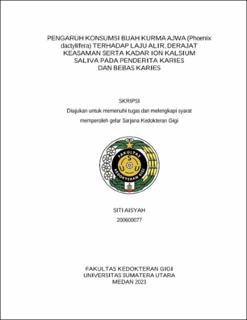Pengaruh Konsumsi Buah Kurma Ajwa (Phoenix Dactylifera) Terhadap Laju Alir, Derajat Keasaman Serta Kadar Ion Kalsium Saliva pada Penderita Karies dan Bebas Karies
Effects of Consuming Ajwa Date (Phoenix dactylifera) on Salivary Flow Rate, Degree of Acidity and Calcium Ion Concentration in Caries and Caries Free Subjects
Abstract
Dental caries is the most common oral disease in society. Saliva parameters, such as flow rate, degree of acidity (pH), and saliva ions have a major influence on the development of caries. Ajwa dates have the highest calcium content compared to other varieties of dates. The aim of this research was to find out more about the effect of consuming Ajwa dates on flow rate, pH and salivary calcium ion levels. The type of research used is true experimental research using pretest-posttest control group design. The total sample in this study was 48 people who met the inclusion and exclusion criteria. Saliva was collected before and 5 minutes after treatment. Salivary flow rate is measured by weighing the collected saliva divided by time, saliva pH is measured using a pH meter, and salivary calcium ion levels are measured usingQuantiChrom Calcium Assay Kit. The collected data is processed computerized using the SPSS application. The results of the study showed that there were significant differences in flow rate, pH and salivary calcium ion levels before and after consuming Ajwa dates in caries and caries-free subjects (p<0.05). There was a significant effect after consuming Ajwa dates on the pH and calcium ion levels of saliva in caries and caries- free subjects (p<0.05), as well as on the salivary flow rate in caries subjects (p<0.05), while in caries-free subjects not significant (p>0.05). There was a significant difference in the value of saliva flow rate after consuming Ajwa dates between caries and caries- free subjects (p<0.05), while there was no significant difference in the pH value and salivary calcium ion levels (p>0.05). It can be concluded that consumption of Ajwa dates has a significant influence on flow rate, pH and salivary calcium ion levels in both caries and caries-free subjects
Collections
- Undergraduate Theses [1901]

